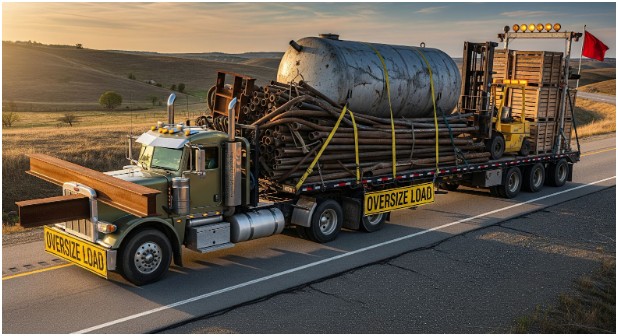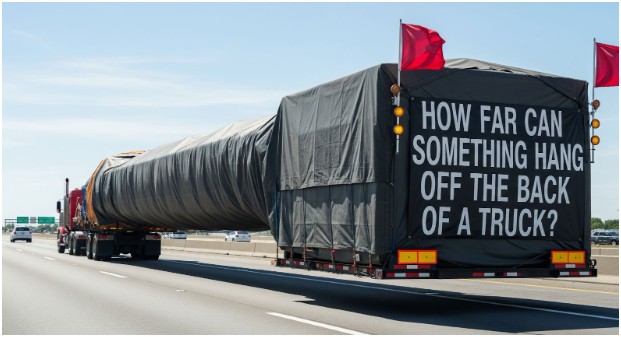If you’ve ever hauled lumber, a ladder, or even a busted sofa that wouldn’t fit inside your bed, you’ve probably wondered: How far can something hang off the back of a truck before it’s too far?
I’ve been hauling tools, gear, and everything in between for over a decade now. From cross-country moves to weekend construction runs, I’ve learned the hard way that it’s not just about tying stuff down—it’s about knowing the law. Let’s break it all down so you stay safe, stay legal, and don’t end up handing over cash for a ticket.
General Guidelines: The Legal Limits on Overhang

There’s no universal one-size-fits-all rule, but most states follow a pretty standard playbook—especially when it comes to personal or non-commercial trucks.
Rear Overhang – Up to 4 Feet
In most states, your load can legally extend up to 4 feet past the rear bumper of your truck. Once you go beyond that, things change—extra marking and possibly even a permit may be required.
Front Overhang – Up to 3 Feet
Not as common for the average truck owner, but if you’re hauling something long over the hood (like pipe or timber on a roof rack), 3 feet is usually the max out front.
Side Overhang – 4 to 6 Inches
Most states won’t let your load stick out more than 6 inches from either side of your truck. Go beyond that, and you’re asking for trouble—especially on narrow roads or in city traffic.
Marking Requirements: Flags, Lights & Legal Visibility

Now if your cargo goes past those basic limits—especially that 4-foot rear line—you’re required to make it visible to other drivers. That’s not just smart, it’s law.
Daytime: Red or Orange Flag
- Must be at least 18 inches square
- Tied to the end of the load
- Required if your overhang is over 4 feet
I keep one folded behind the seat just in case. If you’re pulling long materials even once a year, it’s a must-have.
Nighttime or Low Visibility: Red Lights
- Required if driving after dark or in bad weather
- Must be visible from 500 feet
- Some states also require amber lights on the sides of the load if it’s wide or unusually shaped
And don’t get lazy with a bike light duct-taped to a board. Use a legit red LED or trailer light—it’ll save you from citations or worse.
Permits: When You’re Pushing Past Legal Limits

Sometimes the job calls for a long haul—literally. If your load’s sticking way out and you’re pushing past standard limits, you may need an oversize load permit.
When Permits Are Typically Required
You might need a permit if:
- Rear overhang exceeds 4 feet
- Total vehicle + load length exceeds state limit (often 65–75 feet)
- You’re hauling poles, steel beams, or long industrial materials
- Side overhang exceeds the legal limit
Permits help prevent road hazards, especially on highways or bridges with clearance concerns. And yes, the DOT does check.
What a Permit May Require
- “Oversize Load” signs front and back
- Escort vehicles (for extreme cases)
- Route restrictions, especially in urban areas or near tunnels
- Travel time limits (some states don’t allow oversized loads during peak hours)
If it’s a one-time haul, it’s worth calling your state DOT ahead of time to avoid being turned around or fined mid-trip.
State-by-State Differences (Because Nothing’s Ever Easy)
Now here’s where things can get a little annoying. While federal rules set the tone, state DOTs make the call when it comes to actual enforcement.
Here are a few notable examples:
- California – 4 feet of rear overhang allowed. Over that? You’ll need a flag or light, and potentially a permit.
- Texas – Similar rules apply. But long poles or pipes? There’s a bit more leeway with the right markings.
- Florida – 4 feet max, and very specific about nighttime visibility (don’t skip the red light).
- New York – You might get flagged even with a side overhang past 6 inches.
- Washington – Certain materials like logs or utility poles get special exemptions—but you need the paperwork.
Bottom line: If your haul is longer than your truck, take 10 minutes and check the DOT site for every state you’ll drive through.
Why It Matters: Fines, Tickets, and Real Risk
Let’s talk about what happens when you ignore the rules. I’ve seen guys lose ladders on the freeway or watch 12-foot lumber snap off in traffic. That’s not just dangerous—it’s expensive.
Here’s what you could be looking at:
- Fines ranging from $100 to $500+
- Points on your license (yep, even for a DIY haul)
- Traffic citations or impound
- Insurance claims denied if the load was illegal or unmarked
- Lawsuits if someone gets hurt by debris from your truck
And if you’re driving commercial? The stakes are even higher—violations can impact your DOT safety score and operating authority.
Everyday Items That Trigger Overhang Rules
Here’s the kind of stuff that regularly trips up drivers:
- Lumber and PVC pipe from the hardware store
- Extension ladders
- Mattresses or large furniture
- Steel rods, rebar, or framing studs
- Tool racks or welded parts for job site use
If it sticks past your tailgate, get a tape measure out. That extra 15 seconds might save you a run-in with law enforcement.
Quick Legal Disclaimer (Because It Matters)
This blog is meant for general informational purposes only. I’m a mechanic and hauler—not a lawyer. Always verify with your state’s Department of Transportation (DOT) before loading up. Rules change, and enforcement varies by county and jurisdiction.
Frequently Asked Questions
1. How far can something legally hang off the back of a truck?
In most states, you’re allowed up to 4 feet of rear overhang. Beyond that, you’ll need a flag during the day and red lights at night—possibly a permit.
2. Do I need a red flag for a 3-foot overhang?
Nope. Flags are usually only required if your load extends more than 4 feet. Still, tossing one on is a smart safety move.
3. Can I get pulled over for having stuff stick out?
Definitely—especially if your load isn’t flagged or marked properly. It’s one of the most common hauling violations.
4. Is a permit really necessary?
If you’re hauling something extra-long, extra-wide, or oddly shaped, and it stretches beyond legal dimensions, a permit may be required. Especially on highways or through city routes.
Wrap-Up: Haul It Right or Don’t Haul It at All
So, how far can something hang off the back of a truck?
The simple rule is 4 feet max, but there’s a lot more to it when you factor in visibility, state laws, and safety concerns. Whether you’re a weekend DIYer or a daily hauler, don’t roll out without measuring, marking, and checking the regs.
Because trust me—nothing ruins a good hauling day like a ticket… or a flying ladder on I-95.














